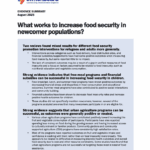Food insecurity is a persistent problem in the United States and is disproportionately distributed across racial/ethnic groups, with some evidence that non-Latino blacks and Latinos experience higher rates than non-Latino whites. But no nationally-representative study examines how race/ethnicity affects food insecurity for immigrants in the United States. Using new assimilation theory and the 1999–2010 waves (N = 32,464) of the National Health and Nutrition Examination Survey (NHANES), this study investigated the relationship between food insecurity and both race/ethnicity and nativity status. Results, when socioeconomic status is held constant, provide evidence for a nonwhite/white divide in food insecurity for both immigrants and the native-born. That is, blacks and Latinos – regardless of nativity status – are significantly more food insecure than both foreign- and native-born whites. These results provide insight into a continuing pattern of racial/ethnic inequality in the United States.
A Systematic Review on the Impact of Trauma-Informed Education Programs on Academic and Academic-Related Functioning for Students Who Have Experienced Childhood Adversity
The purpose of this study was to conduct a systematic review of the existing literature regarding trauma-informed education programs and their impact on academic and academic-related outcomes. The articles included for review (n=15) contained data on trauma-informed education programs implemented in preschool, primary/elementary, and high school settings. Academic and academic-related outcomes reported included attendance, disciplinary…

